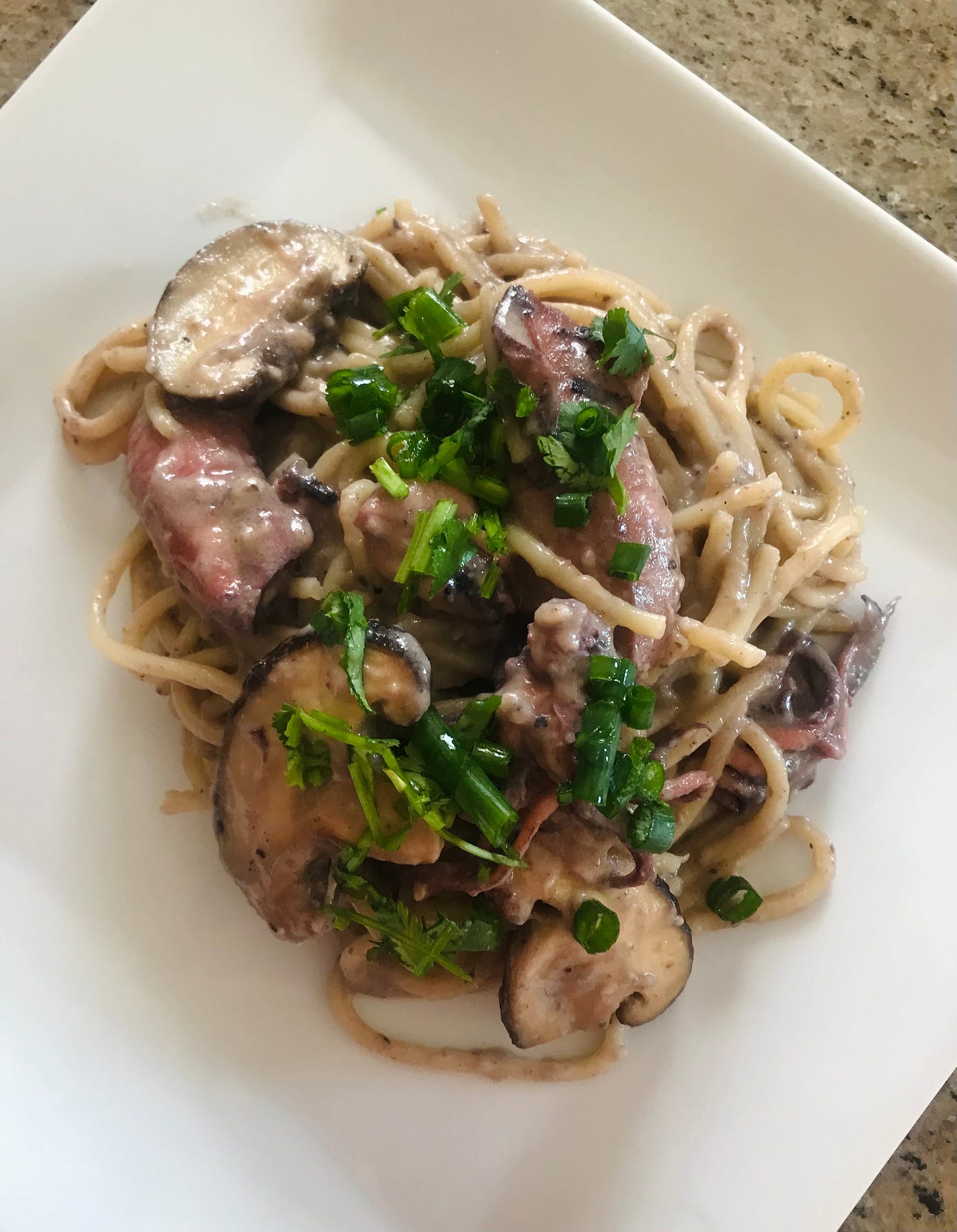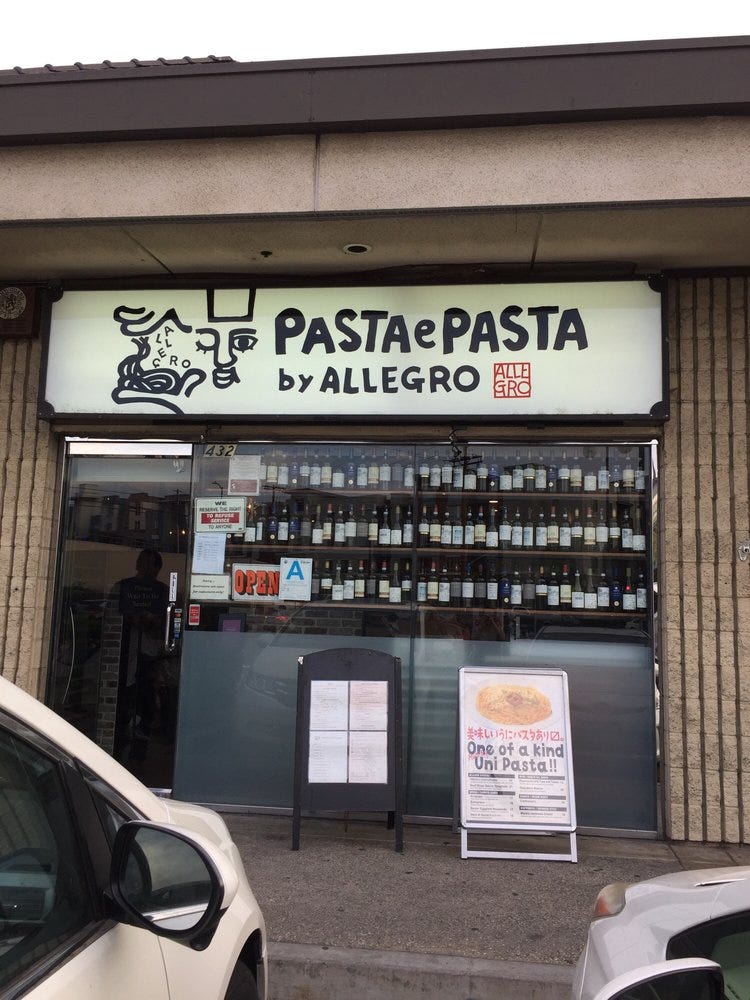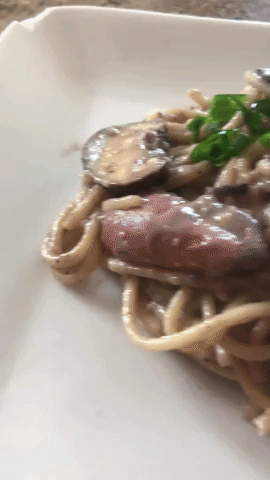March 13th, 2021
The inspiration for the dish
When I was in high school, I remember taking baon (leftovers) from home to school in a glass. During lunch, I'd use the teacher's microwave to heat my food, because who wants to eat cold food? I chose to bring adobong pusit, the squid stewed in soy sauce and vinegar, a common dish among Filipinos. The squid was a unique black and purple, its tiny tentacles visibly glistening and swimming in the sauce and along with slices of tomato. Adobong pusit has a distinct smell when cooked because of the acidic vinegar, soy sauce, and squid. You bet it stood apart from my peers’ Lunchables, PB&J sandwiches, and school-made bean and cheese burritos.
I nuked the adobong pusit in the microwave, and as it began to heat and bubble, it released its fumes into the classroom. The pungent vinegar and squid filled the room and was a punch in the face of my peers and teacher. As is almost a right of passage for young Filipinos and people of color, my family’s dish didn't take well with my classmates and teacher. They threw back off-color comments and nervous chuckles. That was the last time I brought adobong pusit to school.
Several years later, my friend and I were dining in Los Angeles’ Little Tokyo in college. We decided to eat at the famous Pasta E Pasta by Allegro, a Japanese restaurant turning out authentic Italian dishes. One of their signature dishes is the Nero di Sepia or Squid Ink Pasta, squid swimming in creamy, black pasta sauce and noodles, topped with half tomato boats. Mid-slurp of the pasta and squid, I realized that people paid $18 for a dish with black squid ink dish. The same squid that made my friends in high school turn their nose made LA socialites turn their heads and open their wallets. I thought, why not try my own dish: Adobong Pusit Pasta. The dish marries the pungent adobo flavor of the squid and its black ink with Italian pasta's creaminess. Why not embrace being Filipino American and make the food my own way?
The special Pasta E Pasta by Allegro sells Squid Ink Pasta for $18 a plate!
The Adobong Pusit Pasta Recipe
Components
🦑 Adobong Pusit: most people are familiar with pork or chicken adobo, the Philippines' national dish. Adobo means "vinegar-braised." In Filipino cuisine, adobo is a cooking method of braising meat with vinegar and soy sauce over low heat. This technique is applied to any meat, including pusit or squid.
🥛 The pasta sauce: the base of the sauce is a roux, which a fancy French term for equal parts of cooked fat, like butter and flour. Add some more fats like milk and cheese, and you have the foundation for a cheese sauce.
🍝 The pasta: you can choose any basic dry pasta and cook it al dente, meaning still firm when bitten.
Ingredients
As always, use the recipe and the ingredient list as a framework to make it your own. You don't have to be precise with the quantities. Follow the cooking method and "timplahan niyo ito sa sariling gustahan," or season it to your liking. Make it your own! Cook from your heart… and your stomach, as my dad would say.
Adobong Pusit: I adapted my recipe for this component from Kulinarya, A Guidebook to Philippine Cuisine.
18 to 20 pieces of raw, small squid
3 cloves of garlic, minced
1/2 a yellow onion, sliced
2 tomatoes, sliced into strips
3 tablespoons of oil (enough to cover the pan)
1 teaspoon of paprika (or sprinkle it)
2 bay leaves, crushed
1 tablespoon of salt
A sprinkle of pepper to taste
3/4 of a cup of vinegar
2 tablespoons of soy sauce (or a healthy ladle)
6 green finger chilies (siling pangsigang). You can substitute 3 serrano peppers, too, for heat.
Optional: garnish with green onions and cilantro. Make it even fancier with crushed, fried garlic and sliced fried onions.
White Cream Sauce
2 tablespoons of butter
2 tablespoons of flour
1 Cup of Milk (but really, I pour until there's enough sauce)
Optional: your favorite cheese. I went for a mild cheddar last time, but you can use parmesan too!
The pasta
1 pot of water
A pinch of salt
Your favorite boxed pasta
📝 Instructions
To see me assemble the dish, check it out on my Instagram.
Prep Time: 30 mins
Cooking Time: 30 mins
Total Time: 1 hour
Yield: 4 to 6
Cuisine: Filipino, American
Keyword: squid ink, pasta, adobo
Cooking Method: braise and roux
Adobong Pusit
Clean the squid: detach the head from the squid. Remove the ink sacs, and set them aside for later. Discard the beak and the stiff membrane from the body. Clean the squid under running water. I like how Finest Deluxe demonstrates the cleaning!
Heat your pan until very hot. Add your oil and saute your garlic until light brown. Add your onions and half of your tomato. Saute for 2 minutes or until translucent.
Add your squid, paprika, bay leaves, salt, and pepper. Then, saute for 2 to 3 minutes.
Pour your soy sauce and vinegar. Once you pour in your vinegar, don't stir the pot! Don't ask me why but all the Lolas tell me not to disturb the pan once you add the vinegar. Bring the mixture to a boil, then immediately reduce to a simmer and cover.
Add your peppers and simmer for 5 minutes or until the squid is tender. Do not overcook the squid. It cooks faster than other meats and will turn rubbery if exposed to a boil for too long.
White Cream Sauce
Heat your skillet over medium heat and melt the butter.
Add your flour until the flour is cooked (1 to 2 minutes). Be sure not to burn/overheat the mixture.
Pour the milk to your liking and mix until creamy. If your pan is too hot, your milk will burn!
Optional: add your cheese and mix until melted.
The Pasta
Add your pasta and salt to a pot of boiling water. Cook until 2 minutes shy of the instructions on the box or until al dente.
If you don't use the pasta immediately, strain it, run it under cold water, and set it aside.
Serving
Scoop your adobong pusit into the heated cream sauce and mix thoroughly over medium heat. You may have to create a couple of batches depending on the size of your skillet.
Add your pasta and incorporate until the pasta cooks to your preference.
Place in a serving plate and top it with the sliced tomato and garnish. Serve hot!
🎵 Notes
If you want to add more veggies to your dish, saute mushrooms of your choice to the adobong pusit saute of garlic and onions.
You can cook the adobong pusit and pasta components separately and then mix them in the pasta sauce before serving. The cream sauce is fast to make; so, it is best when served fresh and piping hot!
There! You've made your very own Adobong Pusit Pasta or Filipino Squid Ink Pasta. It comes from a ubiquitous meal from the Philippines, but people in the U.S. would shell $20. Pat yourself on the back and enjoy this creamy, inky, delicious meal.
👨🏽🍳How did your creation go?
How did you make the dish your own? Share your experience below. I’m always learning new ways to enjoy food and would love to learn from you!
🧐ICYMI
Some fantastic Filipinos are innovating with pusit. They inspire me to continue to cook with passion and love. Check out some of their works!
Mish Lapi: Queer Pinay/Ilocano whose Instagram Reels have been a source of inspiration and good vibes. She captures the process of creating some mighty delicious dishes, including adobong pusit pancit.
Melissa Miranda: self-described as reliving childhood memories thru Filipinx food, Melissa has been popularizing Filipinx/Filipino food on the national scale. Check out her recipe for adobong pusit pancit on Bon Appetit.
Subscribe to @TheActivistCookbook for more irregular posts about food I like to make, ways I cope with, life, and more. I’m still figuring out the purpose for this blog, but jump on board for the ride! :)





